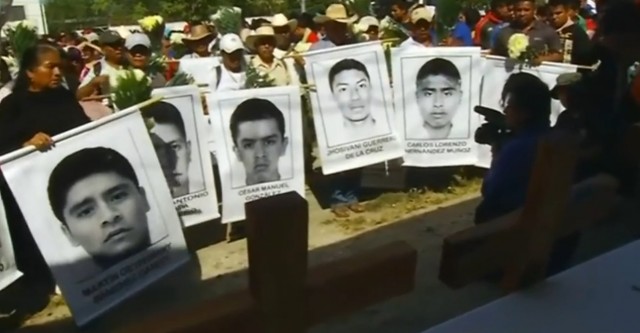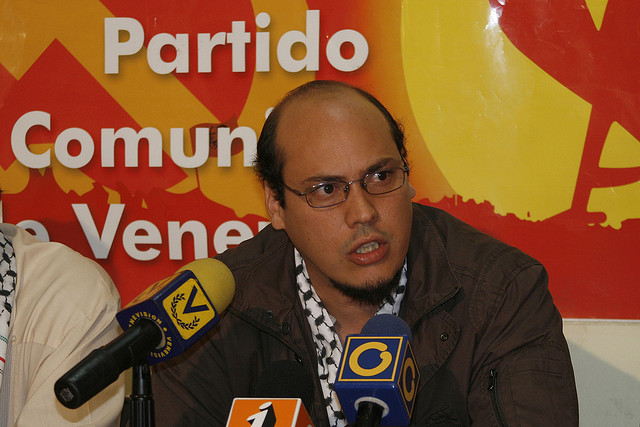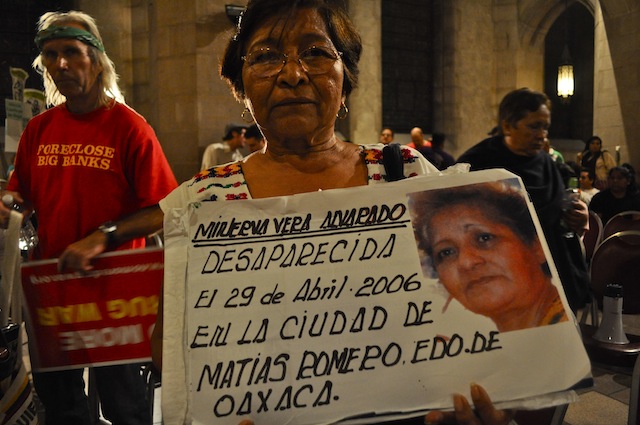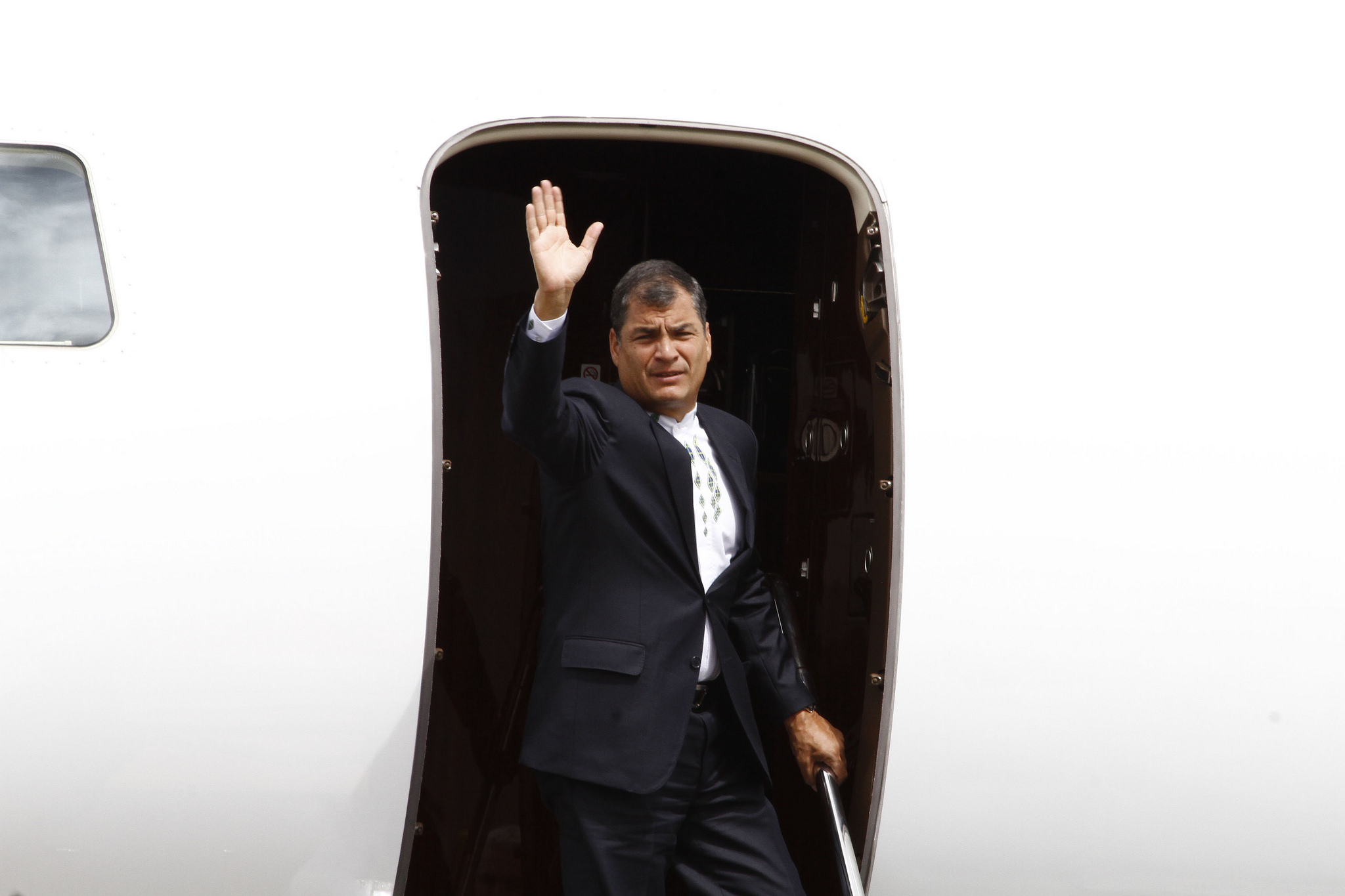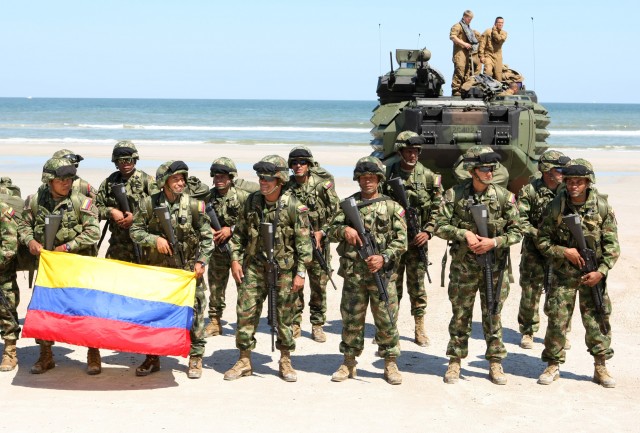
Andes, Colombia, Dispatches, United States
Activists and Journalists Struggle to Make Colombia’s War Visible in the U.S.
October 28, 2014 By Camila Osorio
NEW YORK CITY — Diana Gómez and Shaira Rivera, two young women from Colombia, visited several U.S. universities this month to raise awareness about Colombia’s current peace negotiations to end decades of armed conflict. Both their fathers were killed in the war.
Their fathers, congressional aide Jaime Gómez and union worker Guillermo Rivera, were killed in Colombia in 2006 and 2008, respectively. Although their cases have not been resolved in court, the young Gómez and Rivera accuse Colombian state forces of assassinating their fathers for being left-wing activists.
Military forces have killed at least 2,400 Colombian civilians since 1982, according to statistics from the government-funded research group Historical Memory. Almost none has been tried and punished for these killings. The left-wing FARC have killed around 3,900 people, and paramilitary groups around 9,000.
The U.S. government remains a strong economic and military ally of Colombia despite these human right abuses. “Colombia is the third beneficiary in U.S. military aid in the world,” Gómez told to a group of 15 Columbia University students in early October. Although Colombia receives less military help than Israel and Egypt, it is the third largest beneficiary of U.S. foreign assistance since the counterinsurgency strategy called Plan Colombia was approved in the late nineties.
“It’s your money that is financing the war,” Gómez told the students.
Despite their efforts, the women felt that international organizations and students in the U.S. were not as interested in their speech as in past years. “I don’t know why,” Rivera said in Spanish. Their little noticed visit is a small sample on the difficulty of raising U.S. awareness about Colombia’s war.
The Movement for Peace, a small civil rights organization in New York, organized the event at Columbia for Gómez and Rivera. The group has years of experience trying to get the news media’s and public’s attention.
Although Colombia’s armed conflict started in the mid-20th century, it was in the late 90s that U.S. military support to the Colombian military forces increased considerably. The Movement for Peace was created in that moment, to support peace negotiations and to critique the U.S. military intervention.
“It’s very difficult to change the gringos’ opinion when these governments say constantly that everything is fine in Colombia,” said Gabriel Chaves, a Colombian left-wing immigrant who runs the movement and who invited Gómez and Rivera to New York.
For almost three decades, the movement has been inviting Colombians who challenge the official vision that the country achieved military victory against terrorism, a vision the Colombian and U.S. governments have successfully promoted for the last 14 years.
Chaves thinks the problem is that the movement isn’t big enough. He thinks it should be like the Committee in Solidarity with the People of El Salvador. CISPES was a popular U.S. based organization in the 80s that critiqued the U.S. intervention in El Salvador’s civil war. It had offices all around the country.
Colombia’s movement, on the contrary, only has offices in three cities: New York, Boston and Washington. “Colombians aren’t as organized as Salvadorans were during the civil war,” says Chaves.
“One of our problems is that we are all volunteers,” says Cristina Espinel, an ally of the Movement for Peace and a child therapist who directs the Colombian Human Rights Committee in Washington during her free time.
Espinel has been an activist in the U.S. since the 80s when many of her friends were killed or disappeared by the military. She remembers that many international organizations in the U.S. were not interested in her testimony: “One of those organizations just said, ‘We don’t work with that country.’ And hung up on me.”
Ramón Mejía, a retired engineer in New York and a founder of the movement, recalls that some U.S. organizations such as Witness for Peace and the Washington Office of Latin America did support them. The problem, he says, is that most Colombian immigrants don’t support the movement’s positions.
Many Colombian immigrants are Uribistas, meaning that they support the militaristic approach of former right-wing president Álvaro Uribe to end the Colombian armed conflict, instead of the peace agreement approach.
“Uribe’s years in power were very difficult for us,” says Mejia. Uribe was president of Colombia from 2002 to 2010, and he worked constantly to change the country’s reputation from a ‘failed state’ to one that had successfully fought left-wing guerrillas. He also criticized many human rights organizations in Colombia that challenged this vision.
“As in Colombia, all of us who were denouncing human rights abuses here were stigmatized by other Colombians as ‘guerrilla fighters’ or ‘terrorists,’” says Mejía.
But other observers say it is not only the predominance of Uribistas or the lack of organization among Colombian immigrants that have made things difficult for the movement. It is also the lack of media interest.
“If you check the news, before 9/11, Colombia was widely covered,” says Mario Murillo, radio producer, author of the book ‘Colombia and the United States: War, Unrest and Destabilization’, and professor of radio, television and film at Hofstra University. “But after 9/11, the coverage dropped.”
Murillo, who is not involved in the Movement for Peace, says the attacks of Sept. 11, 2001 made it more difficult to call the attention of U.S. media to Colombia’s war or on its current peace process started by president Juan Manuel Santos.
Murillo remembers that former U.S. Secretary of State Colin Powell was set to travel to Colombia before the Sept. 11 attacks to talk about a peace agreement between the Colombian Government and the FARC, but had to fly to Washington because of the attacks. Since then, the news media have focused more on Afghanistan and the Middle East. “The White House has an enormous power to determine the news agenda,” Murillo explains.
Jon Lee Anderson, a staff writer for The New Yorker who has reported from war zones from Afghanistan to El Salvador, agrees with Murillo. “Media follow what the White House says,” Anderson said in a media panel organized on Oct.17 at Columbia University. “Take Ebola, for example. That was not an important issue in U.S. media until Obama said that he was going to send troops to Liberia.”
Anderson told the audience that U.S. editors are not very interested in Latin America and the Caribbean today. Often, when they do show interest, they fall into stereotypes about dictators, catastrophes and poverty. “But there has not been any serious reporting about Colombia’s peace process in mainstream U.S. media,” Anderson said.
Juan Forero, who writes about Latin America for The Wall Street Journal, remembers that, when all the attention moved to the Middle East, many correspondents left Colombia. He recalls that the Los Angeles Times, The Washington Post, the Miami Herald, the Houston Chronicle and many more U.S. newspapers had reporters in Colombia before the Sept. 11 attacks.
Diana Gómez mentioned in her speech at Columbia University that she fears the current Colombian government is not willing to face the economic and social transformation needed to stop the cycle of violence in the country. That’s what she came to talk about. “We didn’t come all the way here just to make our individual cases visible,” Gómez said. “We want to share what has been a collective experience of violence for many of us, and share that many people are being threatened today as we speak”.
The Colombian civic organization Somos Defensores recently published a report stating that 200 human rights activists were threatened in 2013 and 78 were killed. “It was the deadliest year for human rights defenders,” the report says. Some of those threats were against Sons and Daughters for Memory, the movement to which Gómez and Rivera belong.
The U.S. government keeps supporting the Colombian military campaigns at the same time the Obama administration backs the peace negotiations with the FARC.
“An agreement would be very important to us,” Gómez said to her small audience at Columbia University. “But we just think it’s also important to talk about impunity, about those death threats, about what a post-conflict society should look like.”
The students asked few questions. Few U.S. journalists or Colombian immigrants heard the talk. “This is a slow process,” Rivera said after the event. “We just hope at one point all of this we are saying here will resonate.”
Image: By CWO Keith A. Stevenson, Public Domain
About Camila Osorio
Camila is a Colombian reporter based in New York City. She has published her work in The New Republic, WNYC, PRI, the Colombian website La Silla Vacía, among others. She is currently checking facts at The New Yorker.
< Previous Article
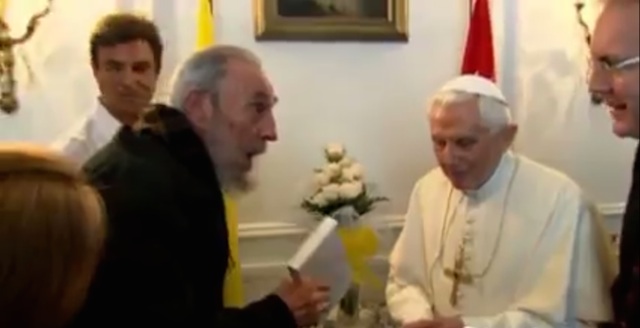
October 28, 2014 > Staff
Cuba to Allow Construction of First New Catholic Church in 55 Years
Next Article >
